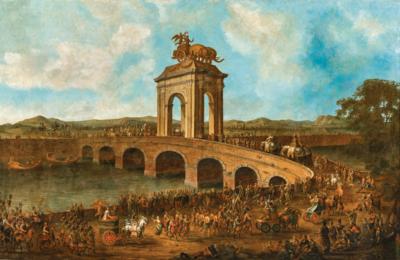Austrian School, 18th Century
A triumphal procession over the Bridge of Augustus,
oil on canvas, laid down on board, 117.5 x 180 cm, framed
Provenance:
Private collection, Upper Austria
The present painting is based on an engraving of the Bridge of Augustus in the Entwurff einer historischen Architektur from 1721 by Johann Bernhard Fischer von Erlach (1656–1723). The monumental canvas depicts a Roman triumph crossing a bridge – a procession replete with elaborate horse-drawn carriages and exotic elephants, which are given colossal form as statues on top of the arch. In the engraving, Fischer has identified the structure as the Bridge of Augustus on the Via Flaminia that led to Rimini. The vagueness of any topographical reference however can probably be explained by the fact that Fischer had made the engraving in Vienna and had not visited Rome since his stay there as a young man between 1671 and 1687.
Johann Bernhard Fischer von Erlach was a strikingly original architect whose Baroque architecture profoundly influenced and shaped the tastes of the Habsburg Empire. His contribution to the culture of his time resulted from his ability to successfully synthesise the predominant needs and traditions of the time with that of the leading Italian High Baroque architects of the previous generation, including Gian Lorenzo Bernini (1598–1680), who encouraged him to study both ancient and modern sculpture and architecture. Back in Austria in 1687, Fischer von Erlach was installed as a fashionable and sought-after architect, and the empire, which quickly regained strength after the defeat of the Turks in 1683, provided a welcome setting for him to realise his ideas.
Fischer’s Entwurff einer historischen Architektur, presented to Charles VI in 1712 and first printed in Vienna in 1721, is a major work of European architectural history. Only 160 copies were printed of this first edition, the second edition of which appeared in 1725. As proof of the wide scope of his knowledge, this work on the history of architecture may be seen as part of a wave of interest in non-European civilisations that arose in Europe in the latter part of the seventeenth century. The reconstruction of the architecture of ancient Rome in its formal and typological richness corresponded to Fischer’s actual task of creating modern imperial architecture in Vienna, including Schönbrunn Palace, Karlskirche, and the Austrian National Library.
Expert: Dr. Alexander Strasoldo
 Dr. Alexander Strasoldo
Dr. Alexander Strasoldo
+43 1 515 60 403
old.masters@dorotheum.com
25.10.2023 - 18:00
- Dosažená cena: **
-
EUR 16.900,-
- Odhadní cena:
-
EUR 15.000,- do EUR 18.000,-
Austrian School, 18th Century
A triumphal procession over the Bridge of Augustus,
oil on canvas, laid down on board, 117.5 x 180 cm, framed
Provenance:
Private collection, Upper Austria
The present painting is based on an engraving of the Bridge of Augustus in the Entwurff einer historischen Architektur from 1721 by Johann Bernhard Fischer von Erlach (1656–1723). The monumental canvas depicts a Roman triumph crossing a bridge – a procession replete with elaborate horse-drawn carriages and exotic elephants, which are given colossal form as statues on top of the arch. In the engraving, Fischer has identified the structure as the Bridge of Augustus on the Via Flaminia that led to Rimini. The vagueness of any topographical reference however can probably be explained by the fact that Fischer had made the engraving in Vienna and had not visited Rome since his stay there as a young man between 1671 and 1687.
Johann Bernhard Fischer von Erlach was a strikingly original architect whose Baroque architecture profoundly influenced and shaped the tastes of the Habsburg Empire. His contribution to the culture of his time resulted from his ability to successfully synthesise the predominant needs and traditions of the time with that of the leading Italian High Baroque architects of the previous generation, including Gian Lorenzo Bernini (1598–1680), who encouraged him to study both ancient and modern sculpture and architecture. Back in Austria in 1687, Fischer von Erlach was installed as a fashionable and sought-after architect, and the empire, which quickly regained strength after the defeat of the Turks in 1683, provided a welcome setting for him to realise his ideas.
Fischer’s Entwurff einer historischen Architektur, presented to Charles VI in 1712 and first printed in Vienna in 1721, is a major work of European architectural history. Only 160 copies were printed of this first edition, the second edition of which appeared in 1725. As proof of the wide scope of his knowledge, this work on the history of architecture may be seen as part of a wave of interest in non-European civilisations that arose in Europe in the latter part of the seventeenth century. The reconstruction of the architecture of ancient Rome in its formal and typological richness corresponded to Fischer’s actual task of creating modern imperial architecture in Vienna, including Schönbrunn Palace, Karlskirche, and the Austrian National Library.
Expert: Dr. Alexander Strasoldo
 Dr. Alexander Strasoldo
Dr. Alexander Strasoldo
+43 1 515 60 403
old.masters@dorotheum.com
|
Horká linka kupujících
Po-Pá: 10.00 - 17.00
old.masters@dorotheum.at +43 1 515 60 403 |
| Aukce: | Obrazy starých mistrů |
| Typ aukce: | Sálová aukce s Live bidding |
| Datum: | 25.10.2023 - 18:00 |
| Místo konání aukce: | Wien | Palais Dorotheum |
| Prohlídka: | 14.10. - 25.10.2023 |
** Kupní cena vč. poplatku kupujícího a DPH
Není již možné podávat příkazy ke koupi přes internet. Aukce se právě připravuje resp. byla již uskutečněna.

